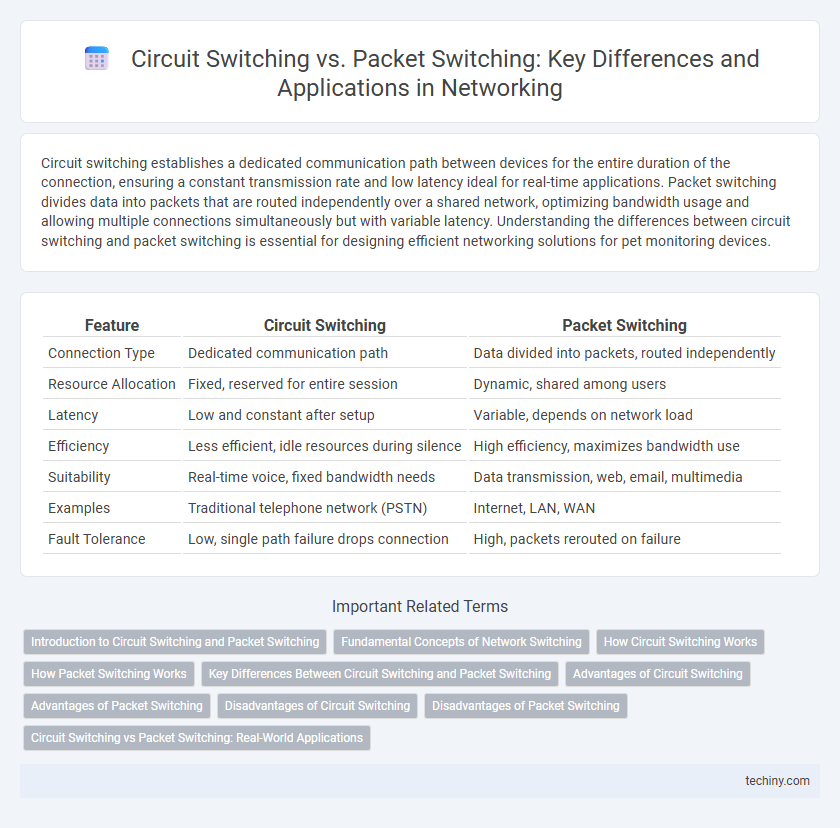Circuit switching establishes a dedicated communication path between devices for the entire duration of the connection, ensuring a constant transmission rate and low latency ideal for real-time applications. Packet switching divides data into packets that are routed independently over a shared network, optimizing bandwidth usage and allowing multiple connections simultaneously but with variable latency. Understanding the differences between circuit switching and packet switching is essential for designing efficient networking solutions for pet monitoring devices.
Table of Comparison
| Feature | Circuit Switching | Packet Switching |
|---|---|---|
| Connection Type | Dedicated communication path | Data divided into packets, routed independently |
| Resource Allocation | Fixed, reserved for entire session | Dynamic, shared among users |
| Latency | Low and constant after setup | Variable, depends on network load |
| Efficiency | Less efficient, idle resources during silence | High efficiency, maximizes bandwidth use |
| Suitability | Real-time voice, fixed bandwidth needs | Data transmission, web, email, multimedia |
| Examples | Traditional telephone network (PSTN) | Internet, LAN, WAN |
| Fault Tolerance | Low, single path failure drops connection | High, packets rerouted on failure |
Introduction to Circuit Switching and Packet Switching
Circuit switching establishes a dedicated communication path between two nodes for the duration of the connection, ensuring consistent bandwidth and low latency ideal for real-time voice calls. Packet switching divides data into packets that are routed independently across shared networks, optimizing resource use and allowing for efficient and flexible data transmission. These core networking methods underpin the design of telecommunication and internet systems, influencing performance and scalability.
Fundamental Concepts of Network Switching
Circuit switching establishes a dedicated communication path between two nodes for the duration of the transmission, ensuring a constant and predictable connection with fixed bandwidth. Packet switching divides data into packets that are routed independently across shared network paths, optimizing resource utilization and allowing dynamic path selection for improved fault tolerance. The fundamental distinction lies in resource allocation: circuit switching reserves fixed channels, while packet switching leverages statistical multiplexing to maximize network efficiency.
How Circuit Switching Works
Circuit switching establishes a dedicated communication path between two nodes for the duration of the transmission, ensuring a constant and ordered flow of data. This method reserves the entire bandwidth of the channel, providing guaranteed quality of service and minimal latency ideal for real-time applications like voice calls. Once the connection is terminated, the circuit is released and made available for other transmissions.
How Packet Switching Works
Packet switching divides data into smaller packets that are independently routed through a network based on the destination address in each packet's header. Each packet may take a different path to the destination, where they are reassembled in the correct order to form the original message. This method optimizes network resource use by allowing multiple data streams to share the same transmission channels dynamically.
Key Differences Between Circuit Switching and Packet Switching
Circuit switching establishes a dedicated communication path between two endpoints for the duration of the transmission, ensuring a consistent and predictable connection. Packet switching divides data into packets that travel independently over shared network resources, optimizing bandwidth utilization and enabling dynamic routing. Circuit switching suits real-time applications needing low latency, while packet switching supports scalable and efficient handling of diverse data types and varying traffic loads.
Advantages of Circuit Switching
Circuit switching provides a dedicated communication path with consistent bandwidth and low latency, ensuring stable and predictable performance crucial for real-time applications such as voice calls. It eliminates packet loss and reduces transmission delay since the entire circuit is reserved for the duration of the connection. This fixed path also simplifies error detection and synchronization, enhancing reliability in communication networks.
Advantages of Packet Switching
Packet switching optimizes network efficiency by allowing multiple data packets from various sources to share the same transmission path, reducing bandwidth waste compared to circuit switching. It enhances fault tolerance, as packets can be rerouted dynamically in case of network congestion or link failure, ensuring reliable data delivery. Packet switching supports high scalability and better resource utilization, making it ideal for modern data-intensive applications such as video streaming and cloud computing.
Disadvantages of Circuit Switching
Circuit switching suffers from inefficient resource utilization as dedicated communication paths remain reserved even during idle periods, leading to wasted bandwidth. It struggles with scalability issues because establishing and maintaining circuits for numerous simultaneous users is resource-intensive. Furthermore, circuit switching lacks flexibility and robustness, making it less effective in handling dynamic network conditions and sudden traffic spikes compared to packet switching.
Disadvantages of Packet Switching
Packet switching can lead to increased latency and jitter due to variable routing paths and network congestion, affecting real-time applications like VoIP or video conferencing. The potential for packet loss requires complex error correction mechanisms, which adds overhead and can reduce overall network efficiency. Additionally, the lack of dedicated bandwidth in packet-switched networks may result in unpredictable performance during high traffic periods.
Circuit Switching vs Packet Switching: Real-World Applications
Circuit switching is ideal for applications requiring a constant, dedicated connection such as traditional telephone calls and private leased lines. Packet switching excels in data transmission scenarios like internet browsing, email, and VoIP, where bandwidth is shared dynamically among multiple users. Real-world networks leverage circuit switching for guaranteed quality of service and packet switching for efficient, scalable communication over IP networks.
Circuit Switching vs Packet Switching Infographic

 techiny.com
techiny.com